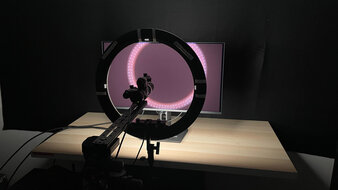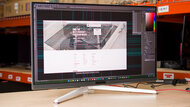There are a few advantages to getting a 1440p monitor for gaming. They strike a balance between having good enough image quality without being too taxing on your graphics card, allowing you to reach high frame rates. These monitors are available in a wide range of refresh rates, even up to 480Hz, so they're great for almost any type of gamer, and even current-gen gaming consoles, like the PS5, PS5 Pro, and Xbox Series X|S, support 1440p signals.
When looking for a 1440p gaming monitor, there are a few things to consider, which we test for as part of our extensive testing on every monitor. Its response time is important for sharp motion handling, and which VRR format it supports ensures compatibility with your graphics card, but most monitors work with any type of graphics card. Low input lag also produces a responsive feel, but most monitors have low input lag anyway. The majority of 1440p monitors are available with a 27- or 32-inch screen, but choosing the right size is a personal preference.
We've bought and tested more than 355 monitors, and below are our recommendations for the best gaming monitors with a 1440p resolution. Also, see our recommendations for the best 1440p 144Hz monitors, the best 1440p monitors, and if you prefer a higher resolution, the best 4k gaming monitors. For more than just a monitor, check out the best gaming laptops and the best gaming headsets.
Quick Look




We buy and test more than 30 monitors each year, with units that we buy completely on our own, without any cherry-picked units or samples. We put a lot into each unbiased, straight-to-the-point review, and there's a whole process from purchasing to publishing, involving multiple teams and people. We do more than just use the monitor for a week; we use specialized and custom tools to measure various aspects with objective data-based results. We also consider multiple factors before making any recommendations, including the monitor's cost, its performance against the competition, and whether or not it's easy to find.
Best 1440p Gaming Monitor
 PC Gaming9.2Response Time9.8HDR Picture9.5SDR Picture10Console Gaming9.1Brightness7.2Size27"Pixel TypeQD-OLEDMax Refresh Rate360 HzSee all our test resultsNative Resolution2560 x 1440
PC Gaming9.2Response Time9.8HDR Picture9.5SDR Picture10Console Gaming9.1Brightness7.2Size27"Pixel TypeQD-OLEDMax Refresh Rate360 HzSee all our test resultsNative Resolution2560 x 1440The best 1440p gaming monitor we've tested is the ASUS ROG Strix OLED XG27ACDNG. It has exceptional gaming performance and outstanding picture quality, making it ideal for gamers who crave graphically intense games at high frame rates. Its 360Hz refresh rate provides a smooth and responsive gaming feel, and thanks to its HDMI 2.1 bandwidth, you can reach that refresh rate over HDMI, as well as over DisplayPort. It also has a near-instantaneous response time, so fast-moving objects are crisp.
It features a QD-OLED with bright and vivid colors, resulting in realistic images for outstanding picture quality. It also has a few useful features, like a KVM switch, making it easy to switch between different sources. It even displays deep blacks in dark rooms with no blooming around bright objects, though deep blacks look purple in bright rooms. If you're looking for a monitor that displays much deeper blacks in bright rooms, check out our choice below, the ASUS ROG Strix OLED XG27AQDMG.
Best Upper Mid-Range 1440p Gaming Monitor
 PC Gaming9.0Response Time9.9HDR Picture9.0SDR Picture9.9Console Gaming8.3Brightness7.5Size27"Pixel TypeOLEDMax Refresh Rate240 HzSee all our test resultsNative Resolution2560 x 1440
PC Gaming9.0Response Time9.9HDR Picture9.0SDR Picture9.9Console Gaming8.3Brightness7.5Size27"Pixel TypeOLEDMax Refresh Rate240 HzSee all our test resultsNative Resolution2560 x 1440If the ASUS ROG Strix OLED XG27ACDNG is out of your price range or you like to game in a brighter room, check out the ASUS ROG Strix OLED XG27AQDMG. It offers the same near-instantaneous response time as the XG27ACDNG, and motion is sharp, though it has a lower 240Hz refresh rate, so it's not quite as smooth and responsive. It also displays a wide range of colors, despite not being quite as vivid as on the XG27ACDNG. It also lacks the HDMI 2.1 bandwidth commonly found in modern consoles and graphics cards.
However, despite not performing as well in darker rooms, in brighter rooms it actually has some advantages. In addition to displaying perfect blacks in dark rooms, unlike the XG27ACDNG, it also displays fairly deep blacks in brighter rooms, though bright objects reflect more strongly off its screen. It also gets brighter than most OLEDs, and highlights pop in HDR.
Best Budget 1440p Gaming Monitor
 PC Gaming8.2Response Time8.5HDR Picture8.0SDR Picture8.2Console Gaming7.4Brightness8.3Size27"Pixel TypeVAMax Refresh Rate180 HzSee all our test resultsNative Resolution2560 x 1440
PC Gaming8.2Response Time8.5HDR Picture8.0SDR Picture8.2Console Gaming7.4Brightness8.3Size27"Pixel TypeVAMax Refresh Rate180 HzSee all our test resultsNative Resolution2560 x 1440If you're on a budget, you can get some budget-friendly 1440p monitors, like the AOC Q27G3XMN. It has a lower 180Hz refresh rate than the ASUS ROG Strix OLED XG27AQDMG, and while it doesn't have the same outstanding picture quality with perfect blacks as the ASUS either, its picture quality is still better than most entry-level monitors. This is because it has Mini LED backlighting with a good local dimming feature that helps it display deep blacks next to bright highlights, with minimal blooming around bright objects. It even gets brighter than the ASUS, making it better to use in a bright room.
Although it doesn't have the same sharp motion as the ASUS either, it still has a fast enough response time to ensure there isn't much blur trail behind fast-moving objects. However, its response time is slower with some transitions, leading to smearing with dark objects. While it's also a good choice for console gaming, it can't take full advantage of the PS5 or Xbox Series X|S due to the lack of HDMI 2.1 bandwidth. The AOC Q27G40XMN is similar to this monitor and is sold at Best Buy in the US. It gets brighter and has better local dimming performance, but its motion handling isn't quite as good as the Q27G3XMN, and you may encounter issues reaching its maximum refresh rate with full color detail.
Notable Mentions
- Sony INZONE M10S:
The Sony INZONE M10S is a top-of-the-line 1440p gaming monitor with a 480Hz refresh rate. This makes it a better choice for competitive gaming than the ASUS ROG Strix OLED XG27ACDNG. The Sony is something to consider if you want such a high refresh rate, but it tends to cost more than the ASUS, and has worse picture quality.
See our review - LG 27GS95QE-B:
The LG 27GS95QE-B is a competitor to the ASUS ROG Strix OLED XG27AQDMG with nearly the same specs. It performs similarly in terms of gaming, but it doesn't get as bright as the ASUS. It's worth considering if you can find it for less.
See our review - Gigabyte AORUS FO27Q3:
The Gigabyte AORUS FO27Q3 is a high-end monitor that competes with the ASUS ROG Strix OLED XG27ACDNG. It performs similarly and has many of the same features, so it may be worth getting if you can find it for less, but it's also harder to find at times.
See our review
Recent Updates
Jun 26, 2025:
Replaced the MSI MPG 271QRX QD-OLED with the ASUS ROG Strix OLED XG27ACDNG, as the MSI is hard to find. Also, mentioned the AOC Q27G40XMN in the Best Budget section.
Mar 27, 2025:
We removed the LG 27GP850-B/27GP83B-B because it's hard to find. We also replaced the ASUS ROG Swift OLED PG27AQDP with the Sony INZONE M10S in the Notable Mentions.
Feb 19, 2025:
We introduced a new format to the article and updated the text to reflect these changes. Additionally, we removed the ASUS ROG Swift PG279QM and the LG 27GR83Q-B, as they don't provide as much value as the AOC Q27G3XMN. We also removed the ASUS ROG Strix XG27ACS as a Notable Mention.
Dec 11, 2024:
We replaced the Gigabyte AORUS FO27Q3 with the MSI MPG 271QRX QD-OLED because the MSI is easier to find and for consistency with other recommendations. We also added the ASUS ROG Swift PG279QM as the 'Best Mid-Range Monitor' and renamed the LG 27GR83Q-B to the 'Best Lower Mid-Range Monitor' to give another option. In the Notable Mentions, we removed the Samsung Odyssey OLED G6/G60SD S27DG60 and the Gigabyte M27Q X and added the ASUS ROG Swift OLED PG27AQDP, ASUS ROG Strix XG27ACS, MSI MPG 341CQPX QD-OLED, and the FO27Q3 based on the changes to the article.
Sep 18, 2024: We replaced the Dell Alienware AW2725DF and the Acer Nitro XV275U P3biipx with the Gigabyte AORUS FO27Q3 and the AOC Q27G3XMN for consistency with other recommendations and because the Gigabyte and AOC are back in stock. We also replaced the LG 27GS95QE-B with the brighter ASUS ROG Strix OLED XG27AQDMG. Lastly, we updated the Notable Mentions by replacing the Dell Alienware AW3423DWF, LG 27GR95QE-B, and the Gigabyte GS27QC with the 27GS95QE-B, Samsung Odyssey OLED G6/G60SD S27DG60, ASUS ROG Swift PG279QM, and Gigabyte M27Q X.
All Reviews
Our recommendations are based on what we think are the best 1440p gaming monitors currently available. They're adapted to be valid for most people. The rating is based on our review, factoring in price and feedback from our visitors.
If you'd prefer to make your own decision, here is the list of all of our 1440p monitor reviews. Be careful not to get too caught up in the details. Most monitors are good enough to please most people, and the things we fault monitors on are often not noticeable unless you really look for them.





































































